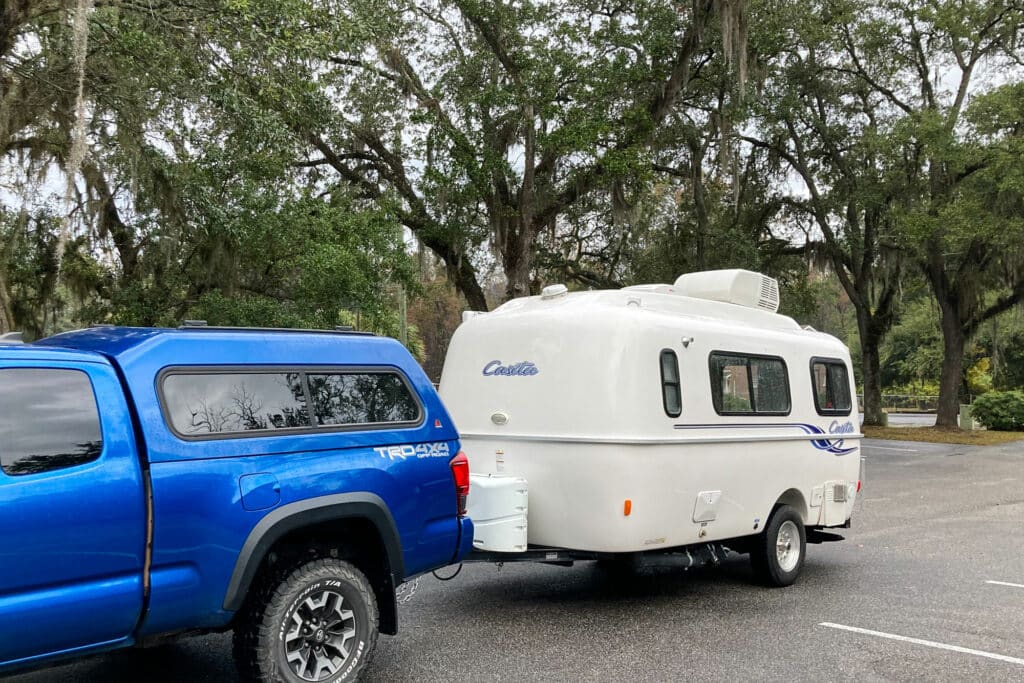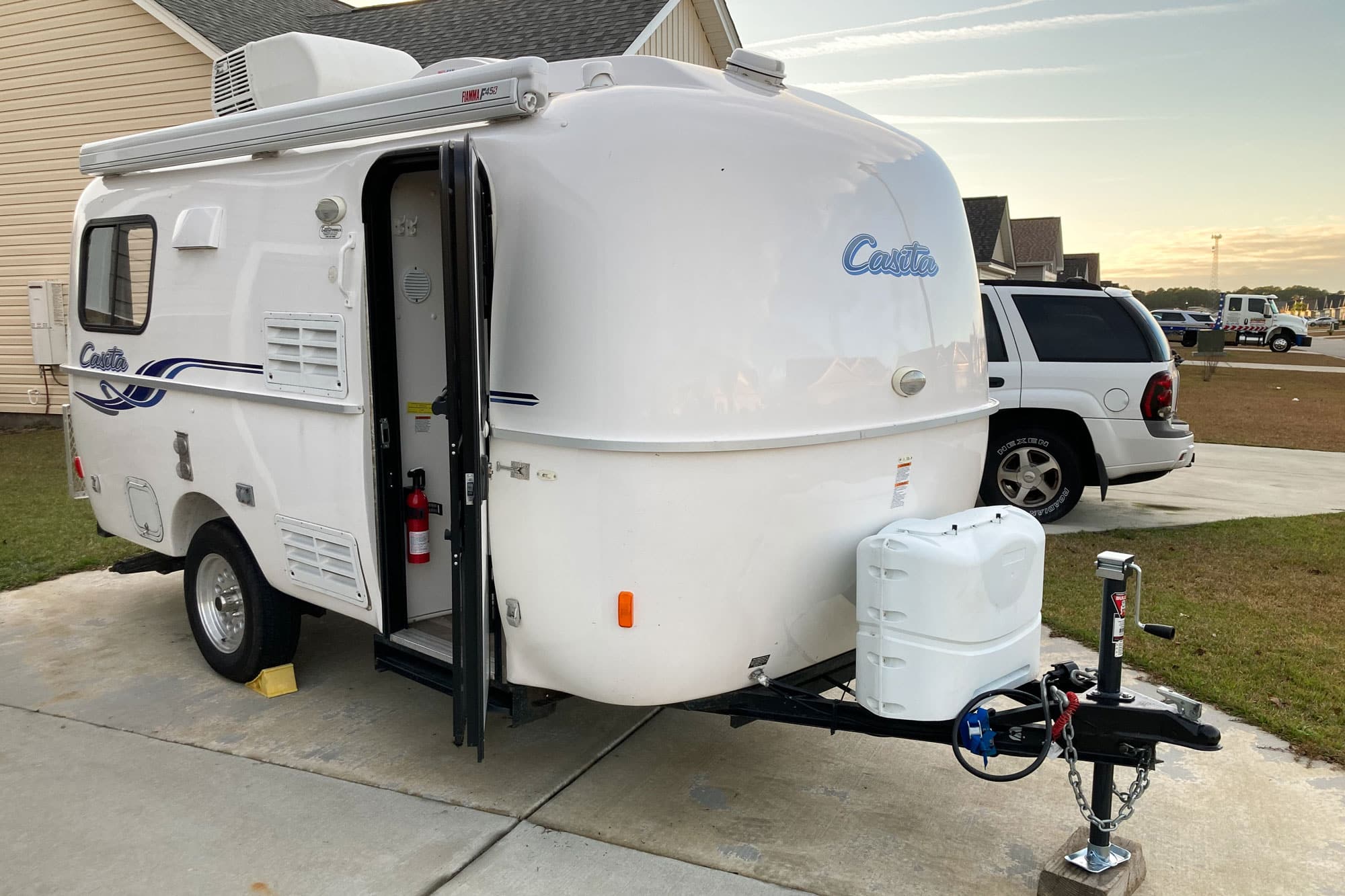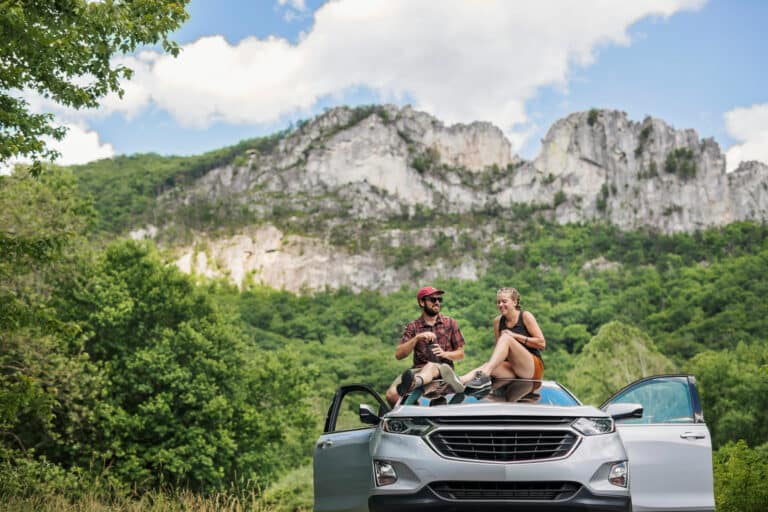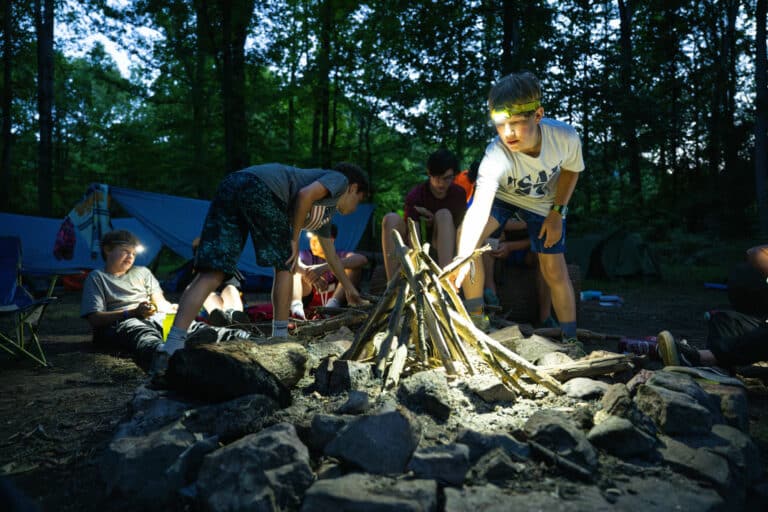Photos courtesy of the author
For an adventurous couple, the road to a dream purchase gets a little rocky.
The white, egg-shaped camper was hitched to my truck on a residential street near downtown Asheville. After only two hectic weeks from idea to purchase, I tentatively handed a cashier’s check to Kenny, the friendly private seller. My wife clutched the title to a 2021 Casita Spirit Deluxe, a 17-foot fiberglass travel trailer. The only thing left was to retract the tongue jack and drive away—no small feat given my limited experience towing occasional raft and kayak trailers.
Kenny was raising the electric jack when we heard a nasty clunk. The inner steel leg and foot plummeted to the ground. Three pairs of eyes suddenly widened.
“It can’t be broken,” muttered Kenny. “It’s only a year old.”
Kenny seemed genuinely shocked and embarrassed. But after confirming the jack was definitely broken, it was hard to shake the feeling that we had been ripped off. Frankly, it didn’t add up. We were standing outside Kenny’s nice home, where we’d spent the past 20 minutes in his kitchen, doing paperwork and chatting about traveling across the country. Kenny had repeatedly insisted everything was in working order. This being our first camper, I hadn’t considered testing the jack during our inspection.
“I’ll pay for it,” said Kenny, also apologizing several times. “Repair or replacement. Just let me know.”
Now we apparently owned a lightly used camper that couldn’t be taken off the truck. Nor could we drive the five hours home with a jack foot dragging down the highway like a sparkler. A quick phone search showed an RV superstore about 20 miles south. I used cam straps to retract the jack, at best a risky short-term fix.
And we were off! Very slowly, that is, with wide turns through the narrow downtown streets. The transmission was in S4, with the power button on, to prevent early upshifting and the low torque of overdrive gears. I carefully accelerated onto the interstate, trying to get a feel for pulling a 3,000-pound egg—hopefully not a rotten one.
***
“Maybe it’s time to get a camper?” I had said to my wife two weeks earlier, after stumbling across a chunk of freelancing cash in one of those digital wallet apps. Suddenly, I realized what some would call financial disorganization could be conveniently recast as financial discipline. Perhaps I could use this tow-able office to offer backcountry seminars about socking away money in easily forgotten icons on one’s phone.
I figured it might take a leisurely year or two from idea to purchase. It was early November 2022. The rush of early pandemic impulsive camper buying was over. Now seemed like the right time to watch for the sell-off. Fortunately, I’d already spent years narrowing in on the target—and not just with online research.
Whenever I saw a Casita in the wild, I basically stalked it like a private detective. I examined the two-piece fiberglass construction, essentially a top bowl placed over a bottom bowl, which helps reduce leaks. I peered inside and crawled under parked Casitas. Yes, I usually asked the owners first. Some of them later regretted inviting me inside, where I performed crime-scene-level investigations. I even followed a few Casitas on the open road, chasing them over mountains and across rough deserts. Based upon the nimble maneuvering by the tow-vehicle drivers, perhaps to shake the tail, I knew the lightweight Casita was the one.
Within a few hours of searching on sites like Fiberglass RVs for Sale and RV Trader, a perfect match miraculously appeared—a Casita Spirit Deluxe, only five hours away, with the exact features desired. High-lift axle and alloy wheels that could handle all-terrain tires for backcountry boondocking. Space for a full bed. A/C and furnace. Mini kitchen with fridge and dinette. A bathroom with shower that—if a six-foot person like me ducks while bending at the knees—practically has vaulted ceilings.
“I’m an old hippie from California,” explained Kenny during our calls. The camper was available but with a catch. He and his wife were semi-retired, splitting time between the California coast, Asheville, and Quebec. The camper was with them in Canada, and they would sell it in two weeks, upon return to North Carolina. Waiting for them were a dozen local parties foaming at the mouth, ready to pounce. After hitting it off with Kenny on the phone, and verifying things with photos and internet sleuthing, I settled on a risky course of action: a deposit to snatch the camper away from the closer locals.
Once the date was set, I spent every spare moment researching anything relevant. I interrogated friends with campers and trailers. I read countless online articles. I even rode my bike around the neighborhood, talking to anyone with a camper who didn’t run me off their lawn. In the span of 10 days, I connected a ScanGauge II to monitor transmission temps. I opened up my truck’s dashboard, and sifted through wires, to install a Redarc brake controller. That way, the Casita’s electronic brakes would work on our long drive back to the coast. I picked up an adjustable hitch mount to level the trailer. While my wife drove us to Asheville, I hurriedly reviewed YouTube videos about towing the thing.

Flash forward five hours. My wife was in the passenger seat, and I was behind the wheel, towing our very first camper. My primary goals were mostly about avoiding things:
curbs, jackknifing, divorce. As I pulled into Camping World, an RV rookie with a busted tongue jack, I was flooded by familiar memories. When I learned to whitewater kayak over 20 years ago, I probably flipped and swam roughly 12 million times. When I began mountain biking over 15 years ago, I went over the handlebars on my very first ride. When I started backcountry skiing over a decade ago, I ended up sliding down a mountain on my butt. New things are tough and rarely go as planned.
“It’s done for,” diagnosed the service technician. The electric jack had been left uncovered for 18 months, which allowed rainwater and ice to infiltrate the mechanism. Suddenly, I recalled seeing RVers turn a bucket upside down to protect their electric jacks from the elements. A replacement electric jack cost several hundred bucks in-store, plus installation, given my limited knowledge and tools on-hand. But did I even want another dinky electric jack? What I really wanted was a solid manual jack that I could crank on for five minutes while listening to “young people” music—just like when hand-pumping my paddleboard.
In the parking lot, my wife and I stared curiously at the broken tongue jack. My plan had been to get the camper home and take the time to learn how to do our own maintenance. I’m neither the handiest nor the least, but somewhere in the middle. Thus, my first quick-fix idea was an abject failure. I had two wooden blocks and tire chocks. I figured if I drove the rear truck wheels up onto the blocks, this would lift the tongue enough that I could slide the sheared-off jack leg out of the tube and be done with it. This, I quickly learned was a terrible idea. One tire rolled perfectly up onto the block, while the other tire rolled too far and kicked the wooden block backwards—dangerously close to the fiberglass shell. Phew, no damage.
So, I unbolted the jack from the A-frame, which I should have done in the first place. After opening up the motor case and discovering there was no way to disconnect the wires, I nervously had to cut them. We made it home by 11 pm and parked on the street. The next morning, I drove the camper to a nearby church parking lot and practiced backing it up repeatedly while road construction workers watched me, dumbfounded.
For 10 days, the camper was marooned in our driveway, hitched to my truck. I waited through the Thanksgiving holiday for the delayed shipment of a Bulldog manual jack. Kenny proved true to his word, sending back $500, for the jack, our troubles, and what he called “embarrassment reduction.”
By mid-December, after a busy month, we were another step closer to a working camper. There was plenty left to do and learn about, like safely connecting to shore power and installing a permanent bed. But all of that would have to wait. A quick glance at the weather forecast showed an arctic blast was coming, with nighttime lows dipping into the teens. That would give me about a week to figure out the latest challenge: Emptying the water lines and tanks and adding antifreeze to prevent ruptures. An ominous process that sounded like a fantasy film invasion of the icy undead: WINTERIZATION.








